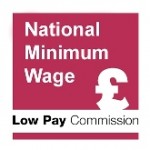On 1 April, the National Minimum Wage (NMW) rates for workers of all ages will increase. Employers will have to pay workers aged 25 and over an hourly rate of at least the National Living Wage (NLW, £8.72), with lower minimum wage rates for 21-24 year olds (£8.20), 18-20 year olds (£6.45), 16-17 year olds (£4.55) and apprentices (£4.15).
Ever since the NMW was first introduced there have always been lower minimum rates for younger workers. But why do young people have lower minimum wages? Why should younger workers get paid less for doing a similar job?
The main reason for setting a lower wage floor for younger workers is to protect employment. The LPC’s remit for young workers is to push pay as high as possible without harming their employment prospects. Evidence shows that younger workers are at higher risk of being priced out of jobs than older workers. They are also more likely to experience a ‘scarring effect’ if they spend time out of work, with lower wages that can last several decades. Above all else, we want to ensure that the youth rates are set at a level that means young people are not excluded from the labour market.
Average wages for younger workers tend to be lower than those for older workers. This could be because they tend to have less experience in the workplace and a weaker bargaining position when negotiating pay. One measure we use to gauge the scope to raise pay is the bite of the minimum wage, calculated as the ratio of the minimum wage to the median hourly pay of that age group. The bite of each of the youth rates is already higher than for the National Living Wage (for those aged 25 and over). The high bite of the youth rates shows how far we have already gone to push up young workers’ pay.
In the last few years, young people have seen rising employment, falling unemployment and robust pay growth, and so we have been able to recommend ambitious increases to the youth rates.
How do employers use the youth rates?
Not all younger workers are paid the youth rates. Fewer than one in ten workers aged 16-24 are paid at the relevant youth rate, and just over a third are paid less than the NLW and are therefore paid somewhere within the youth rate structure.
Last year we asked NIESR[1] to undertake some research to understand how employers set pay for young people. They interviewed employers across four sectors: hospitality, retail, cleaning and childcare. In these sectors, they found that young workers are valued by employers for their flexibility and development potential. Employers were more likely to say that they set pay based on what their competitors offer and what is affordable, rather than the age of the worker.
While some employers may choose to use the youth rates for an initial training period or to offset cost pressures in the business, others pay everyone the same rate regardless of age because they want to appear to be fair and to attract young people to work for them.
What's next for young people's pay?
This research fed into our recent review of the youth rates in which we recommended that the age of eligibility for the NLW should be gradually lowered from 25 to 21. This is because on a range of measures, including educational participation, employment and where and how young people work, 21-24 year olds are similar to older workers aged 25-30 (who are entitled to the NLW). More than 80 per cent of workers in this age group are already paid at the NLW or above, with fewer than one in ten are paid at the 21-24 Year Old Rate.
The Government accepted our recommendations, and the age of eligibility for the NLW will be reduced from 25 to 21 in two stages, moving first to 23 in 2021. This is therefore the last year that 23 and 24 year olds will be paid at the 21-24 Year Old Rate before they are entitled to the NLW.
We will seek to understand how young people’s pay and employment are affected by these changes before we further reduce the age threshold for the NLW to 21. And we will continue to increase pay for younger workers as far as economic circumstances allow.
References
Hudson-Sharp, N., Manzoni, C., Rolfe, H. & Runge, J. (2019). Understanding employers’ use of the National Minimum Wage youth rates. Research report to the Low Pay Commission
Low Pay Commission (2019). A review of the youth rates of the National Minimum Wage
[1] Hudson-Sharp, Manzoni, Rolfe and Runge, 2019
